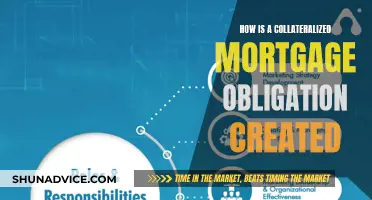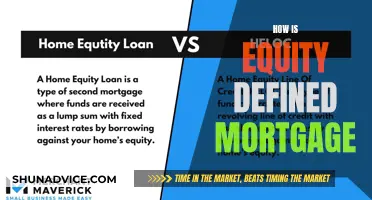
Mortgage-backed securities (MBS) are investments that are similar to bonds. They are created by bundling together multiple mortgages and selling shares of the resulting pool to investors. This process is known as securitization. The simplest form of MBS is the pass-through participation certificate, where investors receive their fair share of both principal and interest payments made on the mortgage bundle. A more complex version of MBS is the collateralized mortgage obligation (CMO), where the pool of mortgages is sliced into similar risk categories, known as tranches. The least risky tranches have more certain cash flows, while the riskier tranches offer higher interest rates. MBS can be issued by government-sponsored enterprises (GSEs) or private financial institutions and are traded on the secondary market.
| Characteristics | Values |
|---|---|
| Type of Security | Debt security, asset-backed security, traded on the secondary market |
| Collateral | A mortgage or a collection of mortgages |
| Creation | Securitization: bundling mortgages and selling shares of the pool to investors |
| Issuers | Government-sponsored enterprises (GSEs), private financial companies, investment banks |
| Credit Rating | Must have one of the top two ratings from an accredited credit rating agency |
| Risk | Not risk-free, higher risk and potentially higher yields if not government-backed |
| Investors | Banks, US government, individuals |
| Investor Income | Regular income through interest and principal payments |
| Investor Profit | Customers pay off their mortgages and the MBS investor profits |
| Investor Payment | Monthly payments, proportional to their investment |
| Types | Pass-throughs, collateralized mortgage obligations (CMOs) |
What You'll Learn
- Mortgage-backed securities (MBS) are bonds secured by mortgages
- MBS are created by bundling mortgages and selling shares to investors
- MBS are traded on the secondary market
- MBS are issued by government-sponsored enterprises (GSEs) or private financial companies
- MBS investors receive periodic payments like bond coupon payments

Mortgage-backed securities (MBS) are bonds secured by mortgages
MBS are investments like bonds. Each MBS consists of a bundle of home loans and other real estate debt bought from the banks that issued them. Investors in MBS receive periodic payments like bond coupon payments. The MBS market has evolved significantly since the 2007-2008 financial crisis, which was largely triggered by the collapse of the subprime mortgage market and the complex web of MBS and related derivatives.
MBS can be issued by government-sponsored enterprises (GSEs) like Fannie Mae, Freddie Mac, and Ginnie Mae, and are considered to be of the highest credit given government backing. These are called agency MBS. Non-agency MBS are issued by private entities and carry higher risk and potentially higher yields since they are not government-guaranteed. MBS can offer regular income through interest and principal payments, portfolio diversification, and potentially higher yields than other fixed-income securities.
There are two basic types of MBS: pass-through mortgage-backed security and collateralized mortgage obligation (CMO). The pass-through mortgage-backed security is the simplest MBS, structured as a trust, so that principal and interest payments are passed through to the investors. It comes with a specific maturity date, but the average life may be less than the stated maturity age. CMOs, on the other hand, are more complex and are constructed by slicing a pool of mortgages into similar risk categories, known as tranches. The least risky tranches have more certain cash flows and lower exposure to default risk, while riskier tranches have more uncertain cash flows and greater exposure to default risk.
Mortgage Borrowing: When Is It Too Much?
You may want to see also

MBS are created by bundling mortgages and selling shares to investors
Mortgage-backed securities (MBS) are investments that represent claims on the money generated by pools of mortgage loans. MBS are created by bundling mortgages and selling shares to investors. This process is known as securitization.
MBS are formed when an investment bank creates a bundle of similar mortgages. The bundle is then placed in a Special Purpose Vehicle (SPV) or Special Investment Vehicle (SIV) to create an MBS. These companies market the MBS to investors. The investor who buys an MBS is essentially lending money to homebuyers. In return, the investor gets the rights to the value of the mortgage, including interest and principal payments made by the borrower.
MBS are asset-backed securities formed by pooling together mortgages. The simplest MBS is the pass-through participation certificate. It pays the holders their fair share of both principal and interest payments made on the mortgage bundle. Pass-throughs are structured as trusts in which mortgage payments are collected and passed to investors. They typically have stated maturities of five, 15, or 30 years. The life of a pass-through may be less than the stated maturity depending on the principal payments on the mortgages.
Another type of MBS is the collateralized mortgage obligation (CMO). These are more complex investments constructed by slicing a pool of mortgages into similar risk categories, known as tranches. The least risky tranches have more certain cash flows and lower exposure to default risk, while riskier tranches have more uncertain cash flows and greater exposure to default risk. The different tranches are given credit ratings, which determine the mortgage-backed securities rates.
Beating Foreclosure: My Second Mortgage Nightmare
You may want to see also

MBS are traded on the secondary market
Mortgage-backed securities (MBS) are traded on the secondary market. This means that MBS are sold to investors after being packaged by an institution such as an investment bank or government institution. The investors who buy MBS are essentially lending money to homebuyers. In return, the investor gets the rights to the value of the mortgage, including interest and principal payments made by the borrower.
The secondary market for MBS is primarily made up of banks and the US government as the two biggest investor classes. However, individuals can also invest in MBS through exchange-traded funds and mutual funds. The MBS market has evolved significantly since the 2007-2008 financial crisis, which was triggered in part by the collapse of the subprime mortgage market and the complex web of MBS and related derivatives. Today, the MBS market remains a major part of the global financial system, with new regulations and increased scrutiny from investors and policymakers.
The process of trading MBS on the secondary market involves the securitization of mortgages. This means that mortgages are pooled together and sold as shares to investors. The investors who buy MBS receive periodic payments similar to bond coupon payments. While MBS can provide regular income and portfolio diversification, it's important to note that no investment is risk-free, and MBS were at the centre of the 2007-2008 financial crisis.
The High Cost of Mansion Mortgages: Average or Exception?
You may want to see also

MBS are issued by government-sponsored enterprises (GSEs) or private financial companies
Mortgage-backed securities (MBS) are created by bundling together multiple mortgages and selling shares of the resulting pool to investors. This process is known as securitization.
MBS are issued by government-sponsored enterprises (GSEs) like Fannie Mae, Freddie Mac, and Ginnie Mae, and are considered to be of the highest credit quality due to their government backing. These GSEs buy mortgages from various lenders, including online lenders, banks, and credit unions, and then package them into MBS. The MBS issued by these GSEs are called agency MBS and carry a government-backed credit guarantee.
On the other hand, non-agency MBS are issued by private financial institutions, also known as non-GSEs, and do not have a government guarantee. These private entities include investment banks and other financial institutions. The securities offered by these companies are grouped by seniority and sold to investors with different risk tolerances.
The creation and sale of MBS by both GSEs and private financial companies provide several benefits. For lenders, MBS allow them to sell off mortgages, freeing up capital to lend to more consumers. Investors, on the other hand, can profit from the mortgage business without directly buying or selling home loans. They receive periodic payments, similar to bond coupon payments, which include interest and principal payments made by the borrowers.
Paying Off My Mortgage: Strategies for Early Freedom
You may want to see also

MBS investors receive periodic payments like bond coupon payments
Mortgage-backed securities (MBS) are investments like bonds. Each MBS consists of a bundle of home loans and other real estate debt bought from the banks that issued them. MBS investors receive periodic payments like bond coupon payments.
MBS investors receive monthly payments that include both interest and a partial return on the principal. This is the main difference between MBS and other types of bonds, which pay out interest twice a year and return the full principal at the end of the term (maturity). The simplest MBS is the pass-through participation certificate, which pays the holders their fair share of both principal and interest payments made on the mortgage bundle. The pass-through MBS is structured as a trust, so that principal and interest payments are passed through to the investors. It typically has a stated maturity of 5, 15, or 30 years. The life of a pass-through may be less than the stated maturity depending on the principal payments on the mortgages that make up the pass-through.
Collateralized mortgage obligations (CMOs) are more complex than mortgage pass-throughs. In a CMO, the mortgages are organized into tranches, or segments, based on rates, risk, and maturity dates. The different tranches are given credit ratings, which determine the mortgage-backed securities rates. The least risky tranches have more certain cash flows and lower exposure to default risk, while riskier tranches have more uncertain cash flows and greater exposure to default risk. The elevated level of risk is compensated for with higher interest rates, which are attractive to some investors.
FICO Scores: Getting Mortgage-Ready
You may want to see also
Frequently asked questions
A mortgage-backed security (MBS) is a type of bond or debt security that is secured by a mortgage or a collection of mortgages. It is a way for investors to profit from the mortgage business without needing to directly buy or sell home loans.
MBS are created by bundling together many mortgages and selling shares of the resulting pool to investors. This process is known as securitization. The mortgages are typically purchased from banks, mortgage companies, and other originators, then assembled into pools by a government, quasi-government, or private entity.
There are two basic types of MBS: pass-through mortgage-backed security and collateralized mortgage obligation (CMO). Pass-throughs are the simplest form of MBS, structured as trusts that pass on principal and interest payments to investors. CMOs, on the other hand, are more complex and involve slicing the pool of mortgages into similar risk categories or tranches.
There are several risks to consider with MBS. Firstly, there is the risk of default by the borrowers. Secondly, there is the risk of extension, where borrowers decide not to make prepayments on their mortgages as expected, leading to lower coupon rates. Lastly, the complex nature of MBS, especially CMOs, contributed to significant losses during the 2006-2008 subprime mortgage crisis.







